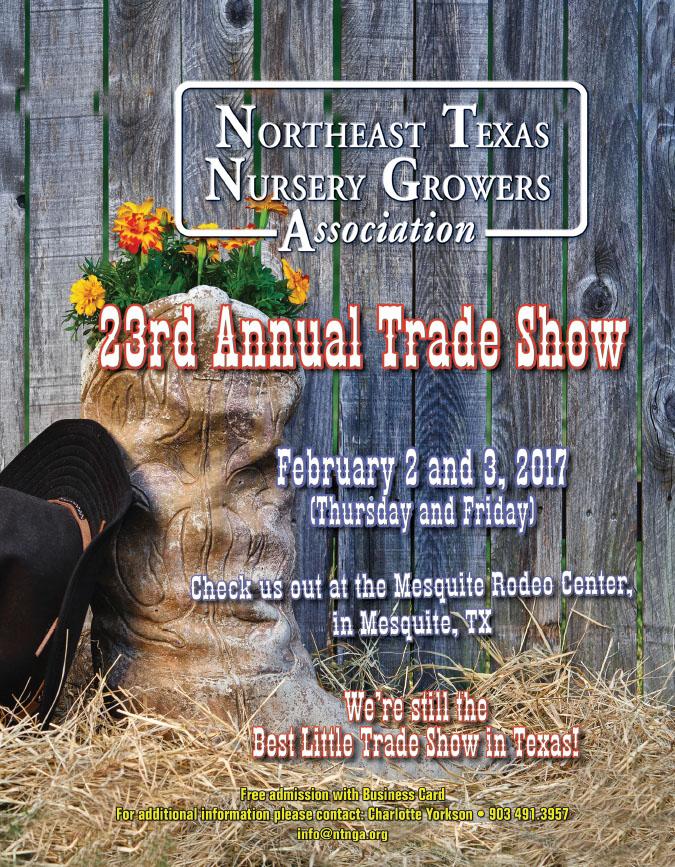|
|
|
|
 |
Greetings!
Wow, it's HOT outside! I know it's summer in Texas, but triple digit heat wears me out. I hope you are able to stay cool yet still get the things done that demand attention. Before you know it school will begin and the fall activities will start.
Our scholarship committee has been at work selecting our recipients for this coming school year. Thanks to your support of the scholarship fund, we are able to offer these scholarships to deserving students pursuing a degree in the Horticulture Industry.
I know many of you are busy preparing to be at the TNLA Expo this month in Houston. Whether you are there as an exhibitor or attendee, don't forget to stop by at the NTNGA booth and say hi. We'll be there promoting each of you and the Association.
Mark your calendar for September 8 when TNLA Region III will be hosting a September meeting at Ran-Pro Nursery in Tyler. Robert Kershaw, from the Kershaw Law Firm, PC will be our speaker. We'll tour the farm at 5:00, the travel to Don Juan on the Square in Tyler at 6:30 for dinner and the program. Don't miss this opportunity to connect and share.
|
 |
 |
|
|

For Exhibitor Information click here
|
|
|
|
|
The sun is not yet up, and a small group of professionals from nurseries and greenhouses in Oregon's Willamette Valley have gathered before the work crew arrives, for an activity that will change the way a nursery does a business process...for the better.
A new consortium has been launched in which nurseries and greenhouse operations work together to deploy Lean in their businesses.
Leaders with the Oregon Nursery Lean Consortium have committed to learning and applying the principles of Lean together for one year. Top practitioners from each company meet for one-day sessions at a hosting nursery. Each involves brief training, followed by immediate application and improvement to an area of the business.
Why Lean?
Lean is a proven method for eliminating waste in processes that results in more value to customers, delivered at a lower cost, in a shorter time, with fewer defects and less human effort. The principles of Lean come from the Toyota Production System and were developed over decades as the company worked its way out of the devastation resulting from the Second World War.
Lean practitioners seek the "least waste way" to perform tasks and processes. It is a never-ending quest. The improvements made today become the baseline for future improvements. As people learn to see and eliminate as much waste as possible from processes, they discover still better ways of performing the work, and the cycle repeats.
The target of Lean is waste. Waste is defined as activities that do not add value to the product or service delivered to the customer. There are seven wastes identified in the Toyota Production System:
- Transportation of raw materials, products, or information
- Inventory or build-up of materials, products, or information
- Motion of people
- Waiting for people, product, raw materials, or information
- Overproducing - making more than the customer requires
- Overprocessing - doing more to the product than the customer requires
- Defects, rework or scrap
"By looking at the seven wastes-and working to remove them-we are definitely more productive and we give more value to our customer today than ever before," says Mark Montville, nursery manager at PRT Oregon. "By looking at value and waste from this perspective I see new opportunities to improve this business every day."
Click here to read the full article to learn about their processes and results.
article taken from:Nursery Management Magazine
|
Did you know there are multiple ways to advertise in the newsletter?
Call 903-272-0145 for pricing
|
|
News and Articles
from the Green Industry
|
Our Favorite Online Resources for Water Management
by American Nurseryman Magazine
The universe of water information seems to be expanding as the reliable supply of water appears to fluctuate, and often it's difficult to decide which way to turn when you're planning for future use. Manufacturers of irrigation equipment can help you determine your infrastructure needs, but where does the water come from in the first place? Should you turn to your utility, or are you fortunate to have access to - and rights to - a natural supply?
We've gathered here a collection of resources to help you find the info you need. There are links to calculators, association references and product information blurbs... all at your fingertips.
. read more
Prepare for more pay - 10 things employers must know about the Department of Labor's new overtime rule.
by Jean Seawright
On May 18, the U.S. Department of Labor (DOL) introduced new rules for classifying white collar workers as exempt from overtime under the Executive, Administrative, and Professional (EAP) exemptions found in the Fair Labor Standards Act (FLSA).
The final rule takes effect Dec. 1, 2016, and incorporates changes to the 2015 Notice of Proposed Rulemaking (NPRM) that are viewed by most employers as less harmful but, nevertheless, a hardship that will have a significant impact on their businesses.
read more
Pinpoint plant problems - Diagnostics makes up a critical part of plant protection.
by Raymond Cloyd
Plant protection helps avoid damage to horticultural crops caused by insects, mites, and diseases. One critical component of plant protection is diagnostics, or assessing what is causing the problem or problems to plants. Plant diagnostics helps determine what is directly and/or indirectly wrong with plants, making it possible to implement corrective measures.
This avoids issues associated with inadequate control or phytotoxicity when using pesticides (insecticides, miticides, and fungicides). When performing plant diagnostics, the first step is to assess patterns of the symptoms expressed by plants. There are three common symptomatic patterns: random, uniform, and clumped. Insect and mite pests, and even diseases, usually cause random or clumped distribution patterns among a crop or individual plant..
read more
|
George R.Brown Convention Center
Houston, Tx.
Thursday, September 8, 2016
TNLA Region III Meeting
(NTNGA members are invited to attend)
Farm Tour
Ran-Pro Nursery, Tyler, TX 5:00pm
Dinner
Don Juan on the Square, Tyler, TX 6:30pm
If you know of any events in your area, or if you are hosting an event, please let me know and we can post it here.
|

Try to stay cool, and if you are heading to Houston, don't forget to stop by our booth and say hi!.
Charlotte Yorkson
Executive Director
Northeast Texas Nursery Growers Association
903-272-0145
|
|
|
|